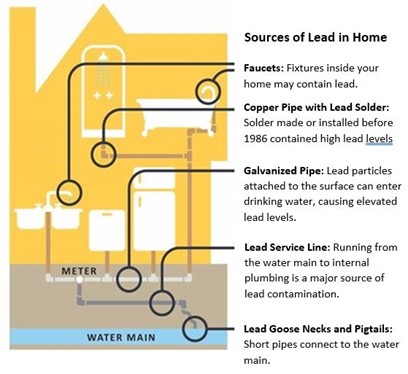Drinking Water Protection
- Drinking Water Protection Home
- About Us
- A-Z Index of Contaminants in Water
- Community Public Water Supply
- Drinking Water Grants and Loans
- Drinking Water Institute
- Drinking Water in Schools and Child Cares
- Drinking Water Revolving Fund
- Laws and Rules
- Noncommunity Public Water Supply
- Source Water Protection
- Water Operator and Certification Training
- Drinking Water Protection Contacts
Related Topics
- Annual Reports
- Drinking Water Risk Communication Toolkit
- Drinking Water Protection External Resources
- Fact Sheets
- Forms
- Invisible Heroes Videos: Minnesota's Drinking Water Providers
- Noncom Notes Newsletter
- Sample Collection Procedures (videos, pictures, written instructions)
- Waterline Newsletter
Related Sites
- 10 States Standards
- Clean Water Fund
- Health Risk Assessment – Guidance Values and Standards for Water
- Minnesota Well Index
- Water and Health
- Wells and Borings
Environmental Health Division
Lead in Drinking Water in Child Care Settings
Lead is a toxic metal commonly found in air, soil, dust, food, drinking water, and in products such as lead based paint. There is no safe level for lead in the body. Reducing levels of lead in drinking water is an important part of reducing the overall exposure to lead.
As a provider of child care services for Minnesota’s children, you value their healthy development. Awareness of environmental concerns and actions that you can take to reduce adverse effects can help make a quality child care experience. This information sheet provides general information about reducing lead in drinking water.

- MDH recommends that all child care providers test for lead in drinking water. Child Care Centers are required to test following MN Statute 145.9273.
- Requirements for child care centers can be found in Chapter 70, Article 4, Sec. 62. [145.9273] Testing for Lead in Drinking Water in Child Care Settings.
- Use the Model Plan to test all taps used for drinking and food preparation.
- Take action to minimize exposure to lead and maintain your drinking water quality after water has been still (overnight/weekend/holiday or other closures).
- Take action to reduce lead exposure whenever a test reveals the presence of lead.
Learn more at Lead in Drinking Water in Child Care Settings (PDF).
Toolkit
This toolkit provides resources for child care providers to communicate about lead in drinking water test results with the families they serve.
Water Infrastructure Improvements
Water Infrastructure Improvements for the Nation (WIIN) Grant can be found at Minnesota Lead Testing in Schools and Child Cares in Drinking Water.
Checklist template for Child Care Centers
Other resource
Environmental Protection Agency (EPA)